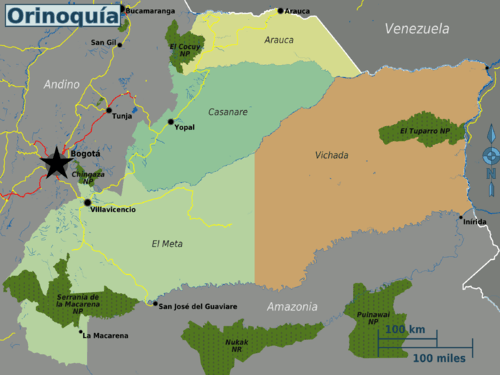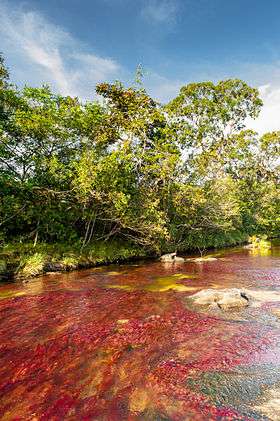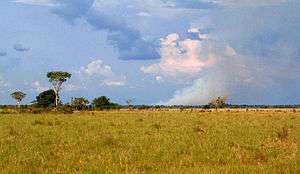Orinoquía
The Orinoquía is the "Wild East" of Colombia. Endless plains — Los Llanos — are dotted with livestock, cowboys on horseback pioneering the landscape, and the roadless landscapes go uninterrupted save by some of Colombia's great meandering rivers. Beyond the region's hub Villavicencio, with its pretty farm hacienda weekend rentals and cow roasts, rare is even the domestic tourist who experiences this vast, unspoiled region. The newest exception, though is the River of Seven Colors in the wondrous Serranía de la Macarena, as the receding lines of battle with the FARC open new lands to adventurous travelers.
Departments

| Arauca |
| Casanare |
| Meta El Meta is a department of the Orinoquía region of Colombia. By far the main attraction here are the haciendas for rent around Villavicencio, which are wildly and rightly popular with Bogotanos looking to escape their high-altitude, colder climate for a weekend or week. The rentals are cheap, and the houses/farms are beautiful, generally with pools in the courtyards. A great escape! This region is largely unknown to international travelers, and most guidebooks to Colombia don't even mention it. |
| Vichada |
Cities
- Arauca
- 🌍 La Macarena
- Puerto Carreño
- Puerto Gaitán
- 🌍 San Martin de los Llanos
- 🌍 Villavicencio— the main town and center of El Meta's hacienda country.
- 🌍 Yopal
Other destinations
- Serranía de la Macarena — most famously home to Caño Cristales, but more generally a natural wonder in every sense, as El Meta's one jungle region, filled with rivers, waterfalls, cliffs, and hot springs.
Understand

Get in
By car
Cars only get you so far in the Meta, as most roads are not paved—plan on needing a jeep or motorcycle if you are going much farther than Villavicencio. The road from Bogotá to Villavo, though, is fine.
For southern parts of the Meta (e.g., La Macarena), the only real option is fly to La Macarena.
By bus
As with a car, bus routes are generally only helpful as far as Villavicencio and a few towns beyond, and those buses run all day long from Bogotá's main bus terminal (Terminal de transporte) for COP$20,000.
By plane
The two airports most commonly used by travelers are La Vanguardia Airport VVC IATA at Villavicencio and La Macarena Airport LMC IATA. Satena Airlines flies between the two (for some reason their English language website doesn't actually allow you to book many of their flights, so be sure to use the Spanish language site only). As the Satena flights from Bogotá have a layover in Villavicencio, you can save a good deal of money on flights to La Macarena by taking a bus to Villavicencio and doing only the second leg of the flight.
Tour companies generally use the little 4-5 seater planes.
By boat
It is possible to take a boat up the Guaviare river from San José del Guaviare, and it most certainly would be a gorgeous ride. But San José is in a very unsafe region, and this should not be attempted.
Get around
See

The most amazing sight in El Meta, and really one of the most amazing sights in all South America, is Caño Cristales, a.k.a. the River of seven colors, a.k.a the most beautiful river in the world. In the period of the year between the rainy and dry seasons, the algae of this always beautiful river turn bright red, leading to an explosion of colors. The hikes in take you right up the river, which you will cross many times. It's way off the beaten path, and most travelers remain pretty wary of traveling in the FARC-heavy region around La Macarena, but it's probably safe to visit just this one place, flying into La Macarena and finding a guide there, or setting up a tour from Bogotá.